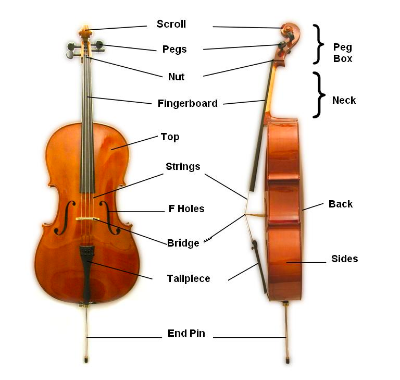cello.music

The name cello is derived from the ending of the Italian violoncello,[2] which means “little violone”. Violone (“big viola”) was a large-sized member of viol (viola da gamba) family or the violin (viola da braccio) family. The term “violone” today usually refers to the lowest-pitched instrument of the viols, a family of stringed instruments that went out of fashion around the end of the 17th century in most countries except England and, especially, France, where they survived another half-century before the louder violin family came into greater favour in that country as well. In modern symphony orchestras, it is the second largest stringed instrument (the double bass is the largest). Thus, the name “violoncello” contained both the augmentative “-one” (“big”) and the diminutive “-cello” (“little”). By the turn of the 20th century, it had become common to shorten the name to ‘cello, with the apostrophe indicating the missing stem.[3] It is now customary to use “cello” without apostrophe as the full designation.[3] Viol is derived from the root viola, which was derived from Medieval Latin vitula, meaning stringed instrument.
Playing Technique
Playing the cello is done while seated with the instrument supported on the floor by the endpin. The right hand bows (or sometimes plucks) the strings to sound the notes. The left-hand fingertips stop the strings along their length, determining the pitch of each fingered note. Stopping the string closer to the bridge results in a higher-pitched sound because the vibrating string length has been shortened. On the contrary, a string stopped closer to the tuning pegs produces a lower sound. In the neck positions (which use just less than half of the fingerboard, nearest the top of the instrument), the thumb rests on the back of the neck; in thumb position (a general name for notes on the remainder of the fingerboard) the thumb usually rests alongside the fingers on the string. Then, the side of the thumb is used to play notes. The fingers are normally held curved with each knuckle bent, with the fingertips in contact with the string. If a finger is required on two (or more) strings at once to play perfect fifths (in double stops or chords), it is used flat. The contact point can move slightly away from the nail to the finger’s pad in slower or more expressive playing, allowing a fuller vibrato.
classical.music
orchestra.music
violin.music
viola.music
contrabase.music
bass.music
bow.music
reed.music
guitar.music
strings.music
bach.music
motzart.music
bethoveen.music
french.music
italian.music
Famous Cellists
Yo-Yo Ma
Pablo Casals
Paul Tortelier
Julian Lloyd Webber
Arthur Russel
Jacques Offenbach
Emanuel Feuermann
Pierre Fournier
Alfred Wallenstein
Han-Na Chang
Hildur Guddnadottir
Janos Starker
Truls Mork
Myung-wha Chung
Beatrice Harrison
Famous Cello Songs
Unaccompanied Cello Suite No. 1
6 Cello Sonatas: No. 4 in G Major
Suite No. 5 inC Minor
Sonata for Violin & Cello, M. 73
Brahms: Piano Concerto No. 2
Brahms: Andante